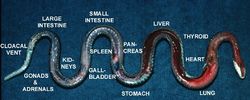Difference between revisions of "Snake Necropsy"
Jump to navigation
Jump to search
| Line 40: | Line 40: | ||
[http://www.cabi.org/cabdirect/FullTextPDF/2010/20103181631.pdf '''Reptile pathology: getting the most out of pathology.''' St. Leger, J.; The North American Veterinary Conference, Gainesville, USA, Small animal and exotics. Proceedings of the North American Veterinary Conference, Orlando, Florida, USA, 16-20 January 2010, 2010, pp 1714-1716, 5 ref. - '''Full Text Article'''] | [http://www.cabi.org/cabdirect/FullTextPDF/2010/20103181631.pdf '''Reptile pathology: getting the most out of pathology.''' St. Leger, J.; The North American Veterinary Conference, Gainesville, USA, Small animal and exotics. Proceedings of the North American Veterinary Conference, Orlando, Florida, USA, 16-20 January 2010, 2010, pp 1714-1716, 5 ref. - '''Full Text Article'''] | ||
| + | |||
| + | [http://www.cabi.org/cabdirect/FullTextPDF/2005/20053197440.pdf '''The reptile necropsy: collection and submission of pathologic samples.''' Garner, M. M.; Eastern States Veterinary Association, Gainesville, USA, Small animal and exotics. Proceedings of the North American Veterinary Conference, Volume 19, Orlando, Florida, USA, 8-12 January, 2005, 2005, pp 1275-1277 - '''Full Text Article'''] | ||
| + | |||
[[Category:Snake_Diagnostics]] | [[Category:Snake_Diagnostics]] | ||
Revision as of 23:24, 4 November 2010
| This article has been peer reviewed but is awaiting expert review. If you would like to help with this, please see more information about expert reviewing. |
External examination
- Measure and weigh the snake and examine the external features.
- Check the skin for bite wounds, bruising, bleeding, ulcerations, burns, swellings, scars, retained shed and ectoparasites.
- Examine the nares, spectacles, eyes, oral cavity and cloaca.
- Assess the musculoskeletal system for body condition and palpate for pathology of the vertebra.
Internal examination
- Open the coelomic cavity. Split the fat body in the median line to expose the organs. Check for fluid.
- Examine all organs in a systematic manner - liver, gall bladder, spleen, pancreas, heart, large vessels, thyroid, lung, oesophagus, stomach, small intestine, large intestine, kidneys, gonads, adrenal glands and eventually the brain.
- Open trachea, lungs, heart, oesophagus, stomach and the intestinal tract, and section other organs as necessary.
- Take swabs as appropriate including heart blood, liver, spleen and kidney.
- Take sterile smear of heart blood for staining.
- Put liver, lung, kidney, spleen and intestine in both formal saline (transfer to 70% ethanol after 48 hours) and frozen in sterile container.
- Make impression smears of different parts of intestines.
- Take a sterile sample of any abnormal gut contents, make a smear in saline.
- Wash the gut contents out in saline, examine for signs of parasites.
- Inspect the gonads to sex definitively
Picture gallery
Literature Search
Use these links to find recent scientific publications via CAB Abstracts (log in required unless accessing from a subscribing organisation).
Snake Necropsy publications






